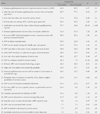Abstract
Purpose
The purpose of this study was to compare knowledge level of those clinical nurses who received HPV vaccine and those who did not and their perception of the relatedness of HPV vaccine to causes of cervical cancer.
Methods
A total of 249 clinical nurses were surveyed from June to July, 2009. The questionnaire originally developed by Kim & Ahn (2007) examined HPV-related knowledge originally and the tool for perception of the causes of cervical cancer was originally developed by Kim (1993). The total number of subjects equaled to: vaccination group of 52 (20.9%) and non-vaccination group of 197 (79.1%).
Results
Vaccination group showed significantly higher score of both knowledge of HPV vaccination and the perception of the cause of cervical cancer in comparison to the nonvaccination group at (p<.05). Among 4 subscales of the perception of causes of cervical cancer, destiny and constitution subscale scores were significantly different between the two groups at (p<.05).
Figures and Tables
Table 2
Differences of HPV-related Knowledge between HPV Vaccinated Nurses and Not Vaccinated Nurses

References
1. Ali S.F., Ayub S., Manzoor N.F., Azim S., Afif M., Akhtar N., et al. Knowledge and awareness about cervical cancer and its prevention amongst interns and nursing staff in Tertiary Care Hospitals in Karachi, Pakistan. PLoS One. 2010. 5(6):e11059.
2. Association of Women's Health, Obstetric and Neonatal Nursing [AWHONN]. HPV vaccination for the prevention of cervical cancer. Nursing for Women's Health. 2010. 14(1):81–82.
3. Bergeron C., Rarraso R., Beaudenon S., Flanant F., Croissant O., Orch G. Human papilloma viruses associated with Great diversity and distinctdistribution in low- and hight-grade lesion. The American Journal of Surgical Pathology. 1992. 16:641–649.
4. Choi K.A., Kim J.H., Lee K.S., OH J.K., Liu S.N., Shin H.R. Knowledge of human papillomavirus infection and acceptability of vaccination among adult women in Korea. Korean Journal of Obstetrics And Gynecology. 2008. 51:617–623.
5. Cohen J. Statistical power analysis for the behavioral sciences. 1988. 2nd ed. Hillsdale, NJ: Lawrence Earlbaum Associates.
6. Daley M.F., Crane L.A., Markowitz L.E., Black S.R., Beaty B.L., Barrow J., et al. Human papillomavirus vaccination practices: A survey of US physicians 18 months after licensure. Pediatrics. 2010. 126(3):425–433.
7. Devi G., Glodowski M., Shin E.. AMWA position Statement; Cervical cancer prevention. Journal of Women's Health. 2009. 18(2):153.
8. Han Y.J., Lee S.R., Kang E.J., Kim M.K., Kim N.H., Kim H.J., et al. Knowledge regarding cervical cancer human papillomavirus and future acceptance of vaccination among girls in their late teens in Korea. Korean Journal of Obstetrics And Gynecology. 2007. 50:1090–1099.
9. Hopkins T.G., Wood N.J., West R.M., Darling J.C. UK health professionals' attitudes and knowledge regarding Human Papillomavirus (HPV) vaccination: A West Yorkshire Study. Journal of Paediatrics and Child Health. 2009. 45(11):652–655.
10. Hsu Y.Y., Hsu K.F., Cheng Y.M., Fetzer S.J., Chou C.Y. Health beliefs of Taiwanese women seeking HPV vaccination. Vaccine. 2010. 28(25):4224–4228.
11. Kang H.S., Moneyham L. Attitudes toward and intention to receive the human papilloma virus (HPV) vaccination and intention to use condoms among female Korean college students. Vaccine. 2010. 28(3):811–816.
12. Kim B.H. An Inquiry into Causal perceptions. 1992. Seoul: Ewha Womans University;Unpublished doctoral dissertation.
13. Kim H.W. Effect of prevention education on human papillomavirus linked to cervix cancer for unmarried female university students. Journal of Korean Academy of Nursing. 2009. 39:490–498.
14. Kim H.W., Ahn H.Y. Study on the knowledge of human papilloma virus in female university students. Korean Journal of Women Health Nursing. 2007. 13:13–20.
15. Kim Y.M., So H.S. A Study on the perceived causal attribution of cancer patients. Journal of Korean Academy of Adult Nursing. 2001. 13:560–570.
16. Klein W.M., Stefanek M.E. Cancer risk elicitation and communication: lessons from the psychology of risk perception. CA: A Cancer Journal for Clinicians. 2007. 57:147–167.
17. Korean Society of Obstetrics and Gynecology. Annual report of gynecologic cancer registry program in Korean for 2004. Korean Journal of Obstetrics and Gynecology. 2007. 50:28–78.
18. Lee J.K. A study for investigating of predictors of compliance for prevention health behavior. The Journal of Nurses Academic Society. 1982. 12:25–38.
19. Markowitz L.E., Dunne E.F., Saraiya M., Lawson H.W., Chesson H., Unger E.R. Quadrivalent human papillomavirus vaccine. Morbidity and Mortality Weekly Report. 2007. 56(RR-2):1–24.
20. Moreira E.D. Jr, de Oliveira B.G., Neves R.C., Costa S., Kari C.G., Filho J. Assessment of knowledge and attitudes of young uninsured women toward human papillomavirus vaccination and clinical trials. Journal of Pediatric and Adolescent Gynecology. 2006. 19:81–87.
21. Muñoz N., Manalastas R.J., Pitisuttithum P., Tresukosol D., Monsonego J., Ault K., et al. Safety, immunogenicity, and efficacy of quadrivalent human papillomavirus (types 6, 11, 16, 18) recombinant vaccine in women aged 24~45 years: A randomised, double-blind trial. Lancet. 2009. 373(9679):1949–1957.
22. No T.Y. Some health promotion activities in hospitals and nursing research on the determinants. 1997. Seoul: Seoul National University;Unpublished doctoral dissertation.
23. No E.J. Asan medical center vs Konkuk university medical center "HPV Vaccine". 2009. 12. 22. Retrieved January 20, 2010. from http://www.dailymedi.com/.
24. Park H.J. A study of on health-promoting lifestyle and its affecting factors of hospital nurses. Korean Journal of Occupational Health Nursing. 2000. 9:94–109.
25. Songthap A., Pitisuttithum P., Kaewkungwal J., Fungladda W., Bussaratid V., Koonsaeng S. Knowledge, attitudes, and acceptability of a human papillomavirus vaccine among healthcare providers. The Southeast Asian Journal of Tropical Medicine and Public Health. 2009. 40(5):1048–1056.
26. Dinh T.A., Rosenthal S.L., Doan E.D., Trang T., Pham V.H., Tran B.D., et al. Attitudes of Mothers in Da Nang, Vietnam toward a Human Papillomavirus Vaccine. The Journal of Adolescent Health. 2007. 40:559–563.
27. Waggoner S.E. Cervical cancer. Lancet. 2003. 361:2217–2225.
28. Walboomers J.M., Jacobs M.V., Manos M.M., Bosch F.X., Kummar J.A., Shah K.V., et al. Human Papillomavirus is a necessary cause of invasive cervical cancer worldwide. The Journal of Pathology. 1999. 189:12–19.




 PDF
PDF ePub
ePub Citation
Citation Print
Print





 XML Download
XML Download